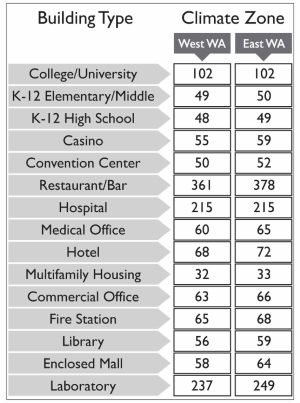|
Subscribe / Renew |
|
|
Contact Us |
|
| ► Subscribe to our Free Weekly Newsletter | |
| home | Welcome, sign in or click here to subscribe. | login |
Construction
| |

March 18, 2021
With Clean Buildings mandates on the horizon, state is stepping up to help fund retrofits
MacDonald-Miller

Building owners, property managers, landlords and businesses throughout the Puget Sound area are already working toward meeting the state's new Clean Buildings requirements, something owners of most buildings 50,000 square feet or larger will need to do.
Those that start this process soon can apply for financial incentives from the state to retrofit their buildings to comply with the state's new standards.
For example, Kemper Development Co. is making improvements to its Bellevue campus to better understand energy usage and is upgrading its building controls. Paccar is also starting to make improvements to its portfolio of facilities around the Puget Sound to better understand its energy consumption using the U.S. Environmental Protection Agency's Energy Star Portfolio Manager.
The Clean Buildings standards, approved by the Legislature through SHB 1257 and signed into law by Gov. Jay Inslee in 2019, make Washington a national leader for mandating energy efficiency numerical targets based on a commercial building's size and use. The performance standards offer the opportunity to reduce greenhouse gas emissions by lowering a building's energy consumption.

Based on the size of the building and how it is used, starting in June 2026, owners must comply or face fines of $5,000 plus $1 per square foot per year. Buildings greater than 220,000 square feet will be the first to meet the requirements by June 1, 2026. Buildings that are 90,000 to 220,000 square feet have until June 1, 2027, to comply, and buildings 50,000 to 90,000 square feet must comply by June 1, 2028. Agriculture and some manufacturing buildings are exempt. Although some buildings don't have to comply for several years, the time to qualify for the state financial incentive is now.
The penalty for non-compliance is steep. That's why the state is offering financial incentives to help offset the costs of needed retrofits for buildings that are more than 15 points away from their performance targets. As part of the Clean Buildings legislation, lawmakers approved $75 million to put toward financial incentives. Funds will be appropriated on a first-come, first-served basis. Building owners could qualify to receive incentives of up to 85 cents per square foot to help offset retrofitting costs. Applications will be accepted starting July 1 of this year.
With financial awards starting in July to those who are the first to apply, it's time for those who own and manage buildings larger than 50,000 square feet to do what's necessary now so they don't miss out. According to initial research, 10,681 commercial buildings in Washington will need to meet the new requirements.
First, owners should benchmark their building's energy use using the EPA's Energy Star Portfolio Manager. This involves reviewing 12 months of utility data, along with the square footage of the building to determine its Energy Use Intensity (EUI). The lower the EUI, the more energy efficient the building is. The new state law establishes maximum energy use by square foot and building type. For example, commercial office buildings have a lower required EUI than hospitals or restaurants.
Once a benchmark is established, conducting an energy audit will determine how to make the building more efficient, to improve its EUI so it complies with state law. The further away from the required standards the building is, the more work will be required to bring it into compliance. Fixes could include improving antiquated technology, such as mechanical equipment and controls, upgrading lighting to LED technology, and making sure systems are working in harmony with each other, rather than against each other. The upgrade costs will depend on what is needed. We have found when the required energy efficiency improvements are done in a smart comprehensive manner that it actually pays for itself within the useful life of the improvements.
Already, Swedish Medical Center's three campuses in Seattle have improved their EUI an average of 7.3%, saving the healthcare provider $778,000 to date. Even before the state passed the Clean Buildings standards, Swedish began modernizing its facilities management approach with advanced system monitoring, smart energy analytics and operational sustainability. It not only has achieved significant EUI improvements and utility savings, but also pivoted to a more predictive model for its preventative maintenance program and is meeting city energy code requirements and is in line with the state's Clean Buildings standards. Our partnership with Swedish continues at every Swedish hospital as the health care system continues its commitment to environmental stewardship.
Having a clean building is a state requirement and it can be good for your business. Don't miss the opportunity to have some of these retrofits paid for by the state by working with a contractor that can provide cost-effective energy-saving solutions and develop energy management plans.
Perry England is vice president of building performance with MacDonald-Miller Facility Solutions, a design-build mechanical contractor based in Seattle.
Previous columns:
- Women find inspiration at construction firms as industry becomes more accepting, 03-11-2021
- Owners drive increasing diversity on public projects — no more ‘give it your best shot', 03-04-2021
- Katerra finds it's not easy to become the Tesla of prefab, mass timber construction, 02-25-2021
- Game over: former Trump Atlantic City casino where stars played goes out with a big bang, 02-18-2021
- Opening of $50M Port Angeles events hall may be pushed a year due to COVID-related funding issues, 02-11-2021
- Residential construction remains strong; spending on nonresidential work slumps, 02-04-2021
- Empty building? Now is the time to upgrade your HVAC system for better air quality, 01-28-2021
- A tall order: Design-build team needed to update elevators on 63-story Muni Tower, 01-21-2021


